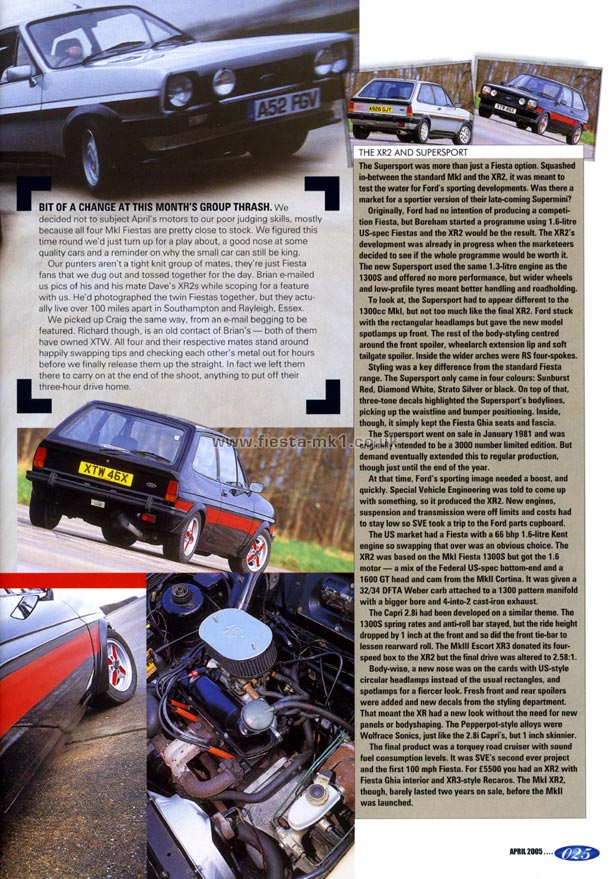Copy of Article Text Below
Bit of a change at this month's group thrash.
We decided not to subject April's motors to our poor judging skills, mostly because all four Mk1 Fiestas are pretty close to stock. We figured this time round we'd just turn up for a play about, a good nose at some quality cars and a reminder on why the small car can still be king.
Our punters aren't a tight knit group of mates, they're just Fiesta fans that we dug out and tossed together for the day. Brian e-mailed us pics of his and his mate Dave's XR2s while scoping for a feature with us. He'd photographed the twin Fiestas together, but they actually live over 100 miles apart in Southampton and Rayleigh, Essex.
We picked up Craig the same way, from an e-mail begging to be featured. Richard though, is an old contact of Brian's - both of them have owned XTW. All four and their respective mates stand around happily swapping tips and checking each other's metal out for hours before we finally release them up the straight. In fact we left them there to carry on at the end of the shoot, anything to put off their three-hour drive home.
THE XR2 AND SUPERSPORT
The Supersport was more than just a Fiesta option. Squashed in-between the standard MK1 and the XR2, it was meant to test the water for Ford's sporting developments. Was there a market for a sportier version of their late-coming Supermini?
Originally, Ford had no intention of producing a competition Fiesta, but Boreham started a programme using 1.6-litre US-spec Fiestas and the XR2 would be the result. The XR2's development was already in progress when the marketeers decided to see if the whole programme would be worth it. The new Supersport used the same 1.3-litre engine as the 1300S and offered no more performance, but wider wheels and low-profile tyres meant better handling and roadholding.
To look at, the Supersport had to appear different to the 1300cc Mk1, but not too much like the final XR2. Ford stuck with the rectangular headlamps but gave the new model spotlamps up front. The rest of the body-styling centred around the front spoiler, wheelarch extension lip and soft tailgate spoiler. Inside the wider arches were RS four-spokes.
Styling was a key difference from the standard Fiesta range. The Supersport only came in four colours: Sunburst Red, Diamond White, Strato Silver or black. On top of that, three-tone decals highlighted the Supersport's bodylines, picking up the waistline and bumper positioning. Inside, though, it simply kept the Fiesta Ghia seats and fascia.
The Supersport went on sale in January 1981 and was originally intended to be a 3000 number limited edition. But demand eventually extended this to regular production, though just until the end of the year.
At that time, Ford's sporting image needed a boost, and quickly. Special Vehicle Engineering was told to come up with something, so it produced the XR2. New engines, suspension and transmission were off limits and costs had to stay low so SVE took a trip to the Ford parts cupboard.
The US market had a Fiesta with a 66 bhp 1.6-litre Kent engine so swapping that over was an obvious choice. The XR2 was based on the Mk1 Fiesta 1300S but got the 1.6 motor - a mix of the Federal US-spec bottom-end and a 1600 GT head and cam from the Mkll Cortina. It was given a 32/34 DFTA Weber carb attached to a 1300 pattern manifold with a bigger bore and 4-into-2 cast-iron exhaust.
The Capri 2.8i had been developed on a similar theme. The 1300S spring rates and anti-roll bar stayed, but the ride height dropped by 1 inch at the front and so did the front tie-bar to lessen rearward roll. The Mklll Escort XR3 donated its four-speed box to the XR2 but the final drive was altered to 2.58:1.
Body-wise, a new nose was on the cards with US-style circular headlamps instead of the usual rectangles, and spotlamps for a fiercer look. Fresh front and rear spoilers were added and new decals from the styling department. That meant the XR had a new look without the need for new panels or bodyshaping. The Pepperpot-style alloys were Wolf race Sonics, just like the 2.8i Capri's, but 1 inch skinnier.
The final product was a torquey road cruiser with sound fuel consumption levels. It was SVE's second ever project and the first 100 mph Fiesta. For £5500 you had an XR2 with Fiesta Ghia interior and XR3-style Recaros. The Mk1 XR2, though, barely lasted two years on sale, before the Mkll was launched.
|







